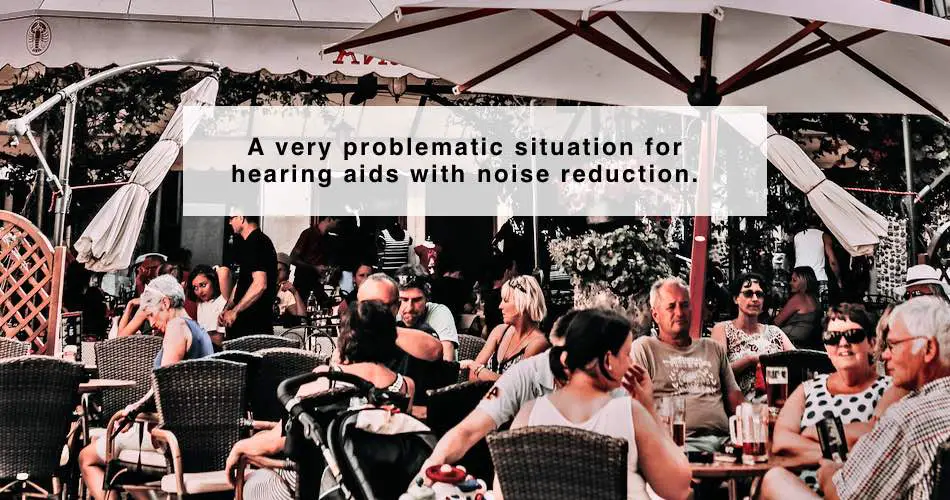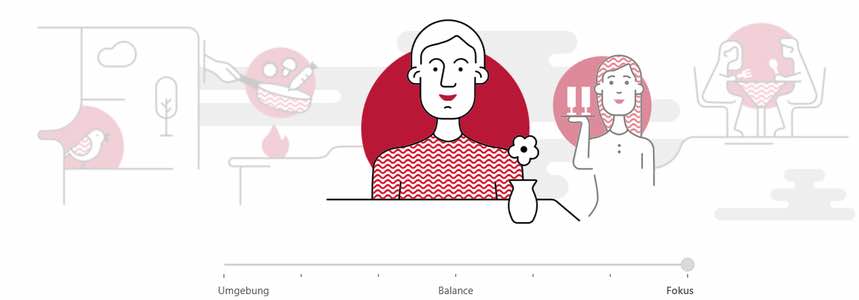Modern hearing aids have noise reduction onboard. Here in this article, you will learn about two things you should look for when buying hearing aids with noise reduction to find the right one for you.
Hearing aids manufacturers currently use two approaches to reduce noise. First is the approach with directional microphones. With this feature, your hearing aids can produce a beam in which you sound better. The smaller the angle of the beam the more focused your hearing aids will become to amplify speech. The direction of the beam can be automatically set by your hearing aids or adjusted by yourself in an app.
The second technology used for noise canceling is digital noise reduction algorithms. In this case, the hearing aid recognizes certain patterns of speech to distinguish the important information from the unimportant. Then the audio processor will digitally reduce the noise to make the speech clearer for you.
The big question I want to address in this article is what kind of hearing aid adjustment will work for you better? Is it the one the noise-canceling with directional microphones or the one with digital noise reduction algorithms? According to a study by Stacie Nordrum et al., it is a 50/50 decision. In this study, each technology was performed for better for one-half of the participants. That means you will not know which of the technologies is right for you without testing it in a noisy environment.

What Is the Best Hearing Aid for Noisy Environments?
There is not a single hearing aid that outperforms all other hearing aids in regards to noise reduction. Usually what new wearers of hearing aids expect due to the marketing done by the hearing aid manufacturers is a hearing aid that totally cuts through the noise. But oftentimes this is not the case even not with the very high-end hearing aids.
Although they have directional microphones and or digital noise reduction algorithms onboard some wearers will be disappointed because might not work as well in their real-world environment as advertised. An interesting excerpt of a study done in 2020 is this one below. (DM stands for directional microphones, NR stands for digital noise reduction, HA stands for hearing aids)
Laboratory data also suggested that DM/NR features could improve listening effort and sound quality compared with no features. However, although both retrospective and in-situ self-reports demonstrated that participants were more satisfied with HAs when the DM/NR features were turned on than turned off, there was no strong evidence to support the effectiveness of premium DM/NR features and premium HAs in the real world.
Study by YU-Hsiang Wu and Elizabeth Stangl et al.
The performance of noise-canceling technologies is also highly tied to the silicone dome or custom earmold used in your ear. To get the most out of noise-canceling a closed dome should be used. Otherwise no matter how good the hearing aid is the effect will be very minimal but more on this in the next paragraph.
How Does Noise Reduction Work in Hearing Aids?
The digital technology of the hearing system permanently analyzes all incoming sound signals. If the interfering sound is detected, the device begins its work. In the first step, the interfering noise is filtered out of the speech signals. In the second step, the interfering sound is attenuated to such an extent that the speech information clearly comes to the fore.
To separate speech from noise, the noise reduction feature must be able to separate noise from speech. This works e.g. by detecting speech pauses. If the speaker pauses and the noise remains, it can be detected by the digital processing of the sound image and subtracted from the total input signal.
The more the noise resembles speech, the less controllable the acoustic situation becomes for the algorithm that is supposed to perform the noise reduction. (This includes, for example, noise with a smaller spectral difference between speech and noise and a change in the position in space where the noise comes from.
Those different acoustic situations can not be improved with only one type of noise reduction. In modern hearing aids different algorithms have to be combined or activated and deactivated depending on the existing acoustic environment.
Another algorithm to improve noise reduction in hearing aids identifies typical speech signals with a maximum in the range of 2-8 Hz. Usually, during a conversation, a certain time is needed to speak, syllables, and phonemes which will combine speech to a rhythm-like structure. Noise, on the other hand, mostly contains a more consistent sound pattern In the frequency range where speech can be located.
When the signals for speech are missing the hearing aids can then reduce amplification to reduce the noise. Here we described the digital filters to reduce noise when wearing hearing aids but there is also the directional microphone technology.
The directional diagram enables this direction-dependent noise reduction to be displayed in an illustrative manner. In the blue areas, the wearer of the hearing aids perceives speech clearer because of optimal amplification levels. In the white areas, less amplification is will be heard and therefore the noise will be less dominant.

As you can see those technologies have their limitations. Imagine you have a conversation with a friend in a crowded cafe and everywhere around is speech. The hearing aid will try several algorithms but when directly behind your friend someone is speaking with a very loud voice this loud person could interfere with the voice you actually want to listen to.
Additional microphones can be very helpful in such a situation that works in combination with your hearing aids.
Can Hearing Aids Be Noise Cancelling?
Hearing aids oftentimes have noise reduction. However, noise reduction does not need to be turned on to the max by default. Your hearing care professional has adjustment handles to make noise reduction perform more dominant or less. In the example below, you can see such an adjustment handle.

Here in the illustration above you can see your conversation partner is set in focus and the hearing aids will now do their best to reduce the noise around you. In contrast, you compare this picture to the one below.

Here every detail of the illustration is presented more colorful and as dominant as the conversational partner. In this case, noise reduction will work less. So in case when you are not satisfied with your hearing aids cutting through noise ask your hearing care specialist if noise reduction can be turned up a little.
And if this does not help look into accessories like external microphones. They are oftentimes a bit of an invest but they will make difficult situations like meetings or a conversation in a crowded place with a friend a lot easier to understand.
I wish you a great day.
